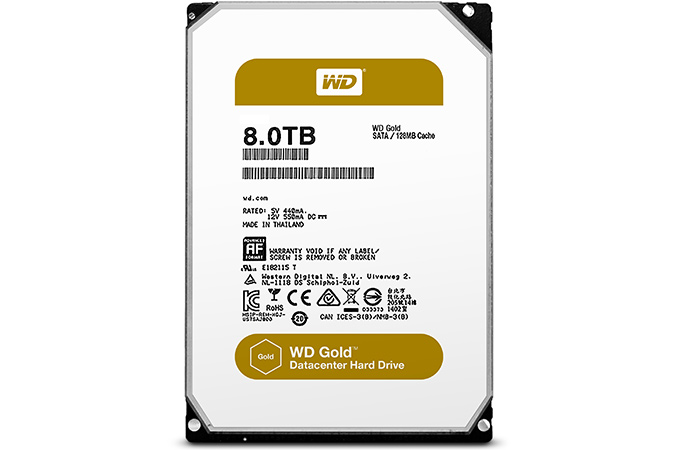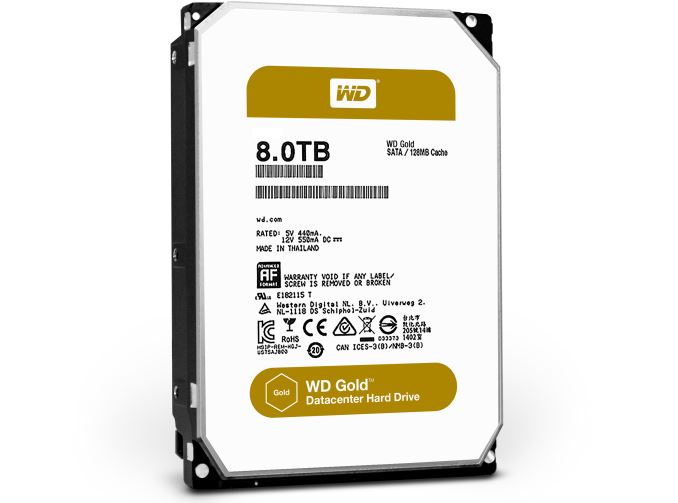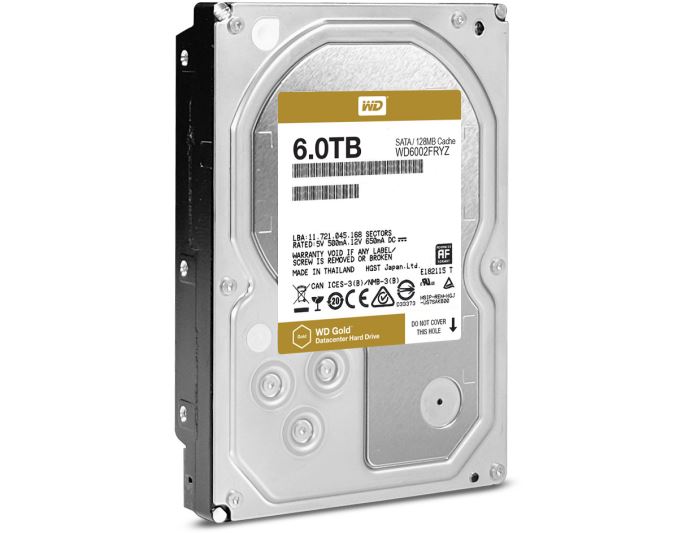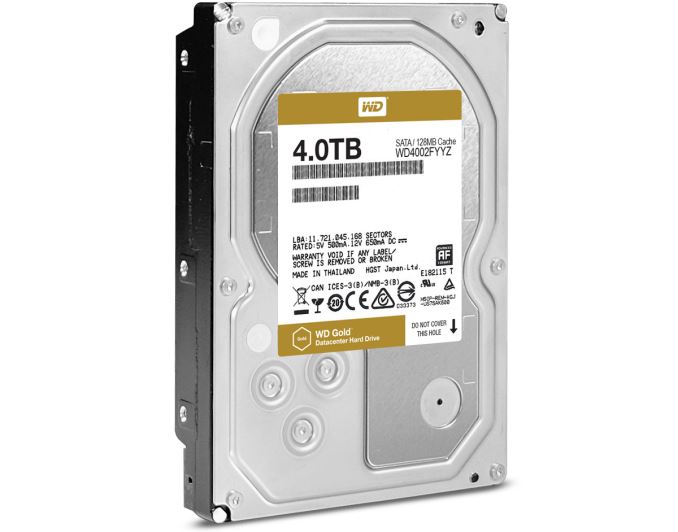Western Digital Introduces WD Gold HDDs for Datacenters
by Anton Shilov on April 19, 2016 9:10 AM EST- Posted in
- HDDs
- WD
- Western Digital
- Enterprise
- WD Gold
- HelioSeal

Western Digital has announced a new family of hard drives specifically for data centers. The new WD Gold HDDs will feature multiple technologies that the company uses to build other drives, including helium and large caches. The WD Gold HDDs will co-exist with the company’s WD Re drives for some time, but as the new family expands, it will eventually replace the previous-gen devices.
The initial WD Gold family will consist of three models: with 4 TB, 6 TB and 8 TB capacities. All three drives seem to be based on different platforms and on different platters, but all of them have 7200 RPM spindle speed and feature new-generation electronics, which is claimed to improve power efficiency by up to 15% according to WD. The new drives come in a 3.5” form-factor and will use SATA 6 Gbps interface exclusively at this point. The WD Gold HDDs are designed for a variety of applications, including small to medium-scale enterprise servers and storage, as well as rack-mount data center servers and storage enclosures.
| Comparison of Western Digital's WD Gold HDDs | |||||
| WD8002FRYZ | WD6002FRYZ | WD4002FRYZ | |||
| Capacity | 8 TB | 6 TB | 4 TB | ||
| RPM | 7200 RPM | ||||
| Interface | SATA 6 Gbps | ||||
| DRAM Cache | 128 MB | ||||
| NAND Cache | No | Yes | Unknown | ||
| Helium-Filling | Yes | No | |||
| MTBF | 2.5 million | ||||
| Rated Workload (Drive Writes Per Day) | 0.189 | 0.251 | 0.377 | ||
| Equivalent of 550 TB of Writes per Year | |||||
| Acoustics (Seek) | 36 dBA | ||||
| Power Rating | 7.40 W | 9.10 W | |||
| Warranty | 5 Years | ||||
| Price | $629 | $499 | $309 | ||
| $0.0768 per GB | $0.0812 per GB | $0.0754 per GB | |||
| 13.02 GB per $ | 12.31 GB per $ | 13.26 GB per $ | |||
Being data center-oriented HDDs, the WD Gold hard drives are optimized for RAID environments and they support enhanced RAFF technology that protects against vibration (by monitoring linear and rotational vibration in real time) as well as head positioning system with two actuators, which improves positional accuracy. The drives also support WD’s time-limited error recovery technology (TLER), which prevents drive fallout caused by extended HDD error recovery processes.
The flagship WD Gold hard drive with 8 TB capacity is Helium based, similar to the HelioSeal platform originally designed by HGST. Western Digital does not reveal the number of platters inside the drive but confirms that these are PMR (perpendicular magnetic recording) platters. Using helium rather than air between the platters helps to reduce power consumption of HDDs compared to non-helium models due to the lower drag force coefficients of helium compared to air - this allows for less friction between heads and the air, as well as platter spinning. All WD Gold HDDs are rated for 2.5 million hours MTBF to signal high reliability.
Next up is the WD Gold 6 TB HDD, which uses a more regular HDD arrangement in air, but which features a media-based cache to improve random write performance over the previous generation WD Re 6 TB hard drive. WD is claiming up to 30% better random write performance. Western Digital does not reveal a lot of details about its “media-based cache”, but it is logical to assume that it uses NAND flash memory as a write buffer which then spins down onto the platters during downtime. Unfortunately, we have no idea about its capacity or actual performance. The drive features modern PMR platters and it may be the world’s first data center-class hybrid HDD (with rotating media as well as NAND cache) for nearline applications. It is interesting to note that also the drives are sold under the WD trademark, they have HGST's markings, which may mean that they were developed by Western Digital's Japan-based subsidiary.
The entry-level WD Gold 4 TB model is claimed to offer up to 18% sequential performance improvement over previous-generation WD Re 4 TB data center drives, but the company does not reveal whether the new HDDs also feature any media-based cache, or its performance advantages are a result of the new electronics, new platters, and/or a new controller. Just like the 6 TB model, the WD Gold 4 TB has HGST Japan marking.
The new family of WD Gold hard drives demonstrates how Western Digital can build HDDs that are tailored for particular needs, which is becoming more important in an industry that is seeing unit volumes decrease over time. The flagship WD Gold 8 TB is optimized for lower power consumption and higher capacity, whereas the mid-range WD Gold 6 TB is optimized for performance.
The new WD Gold HDDs are available at select distributors and resellers in the U.S. as well as from the company’s online store.
Source: Western Digital













30 Comments
View All Comments
ajp_anton - Wednesday, April 20, 2016 - link
Please explain how. Not being sarcastic, I just don't see the low-hanging fruit that enables this with "not that much of a stretch".ddriver - Wednesday, April 20, 2016 - link
HDDs currently employ no form of parallelism whatsoever.Notice how low capacity SSD are usually slower - that's because their low nand chip count and lower level of parallelism. Add more chips, run them in parallel and you get higher badnwidth.
This is not the case of HDDs, they don't get faster with the number of platters increasing, regardless of the number of platters and heads, only one single head will read from one platter surface at a time. Modern HDDs are approaching 200 MB/sec, and have up to 8 platters, that's 16 platter surfaces, and 16 heads. Add in some platter level parallelism, and you get 200 x 16 = 3.2 GB/sec, which is where the fastest PCIE SSD's are.
And that can be achieved without even altering the mechanical design, only by improving the firmware. But there is a lot more improvement that can be achieved by improving on the mechanical design as well.
Scipio Africanus - Wednesday, April 20, 2016 - link
So are some new line or is this a rename of the Re series?Achaios - Tuesday, April 19, 2016 - link
Yesterday, I finished updating my DEC 2013 rig. Upgrades consisted of migrating the components to a new case (Corsair 780T), mounting three additional fans on the case for a total of six, as well as replacing my two WD Green 2TB drives for two brand-new WD Blue 6 TB in Raid 1.I could find no drives for sale with higher than 6 TB capacity. I couldn't even find WD Green 6 TB drives either so I just went with WD Blue 6TB's.
My point is, if WD Blue or Green drives with a capacity of 8 TB were available, I'd buy those instead.
ddriver - Tuesday, April 19, 2016 - link
Blue and Green only have a 2 year warranty. I'd rather get the Black or Red Pro - 5 years warranty, 2.5 as much warranty period for 0.2 extra cost. It is a no-brained.fancarolina - Tuesday, April 19, 2016 - link
Neither the Blue nor Green drives are designed to be used in RAID. Good luck with that you are playing with fire.nils_ - Wednesday, April 20, 2016 - link
Are they still running this sort of broken firmware where the heads are parked after 8 seconds?magreen - Tuesday, April 19, 2016 - link
Blue > 1TB is Green. They renamed the Green series.Squuiid - Tuesday, April 19, 2016 - link
You should have been able to find 8TB Reds in quite a few places, Amazon included.jasonelmore - Tuesday, April 19, 2016 - link
anyone else remember when a 5 year warranty on a Hard drive was common?Even seagates cheap barracuda's had 5 year